Innovation Management in Business: A Case Study of Dyson's Strategies
VerifiedAdded on 2023/06/10
|12
|3835
|390
Report
AI Summary
This report examines Dyson's innovative activities and practices aimed at achieving future success and growth in the household appliances industry. It defines the various innovative activities adopted by Dyson's management and illustrates their understanding of innovation capabilities. The report also discusses models and frameworks that professionals can use to generate ideas for innovation within Dyson. Key areas covered include the future of the household industry beyond 2022, Dyson's innovation requirements, and building future innovation capabilities through knowledge transfer, knowledge management, organizational culture, leadership, and climate. The analysis emphasizes the importance of digital presence, sustainable products, and adapting to changing customer demands to maintain a competitive edge.

Managing Innovation
in Business
in Business
Paraphrase This Document
Need a fresh take? Get an instant paraphrase of this document with our AI Paraphraser
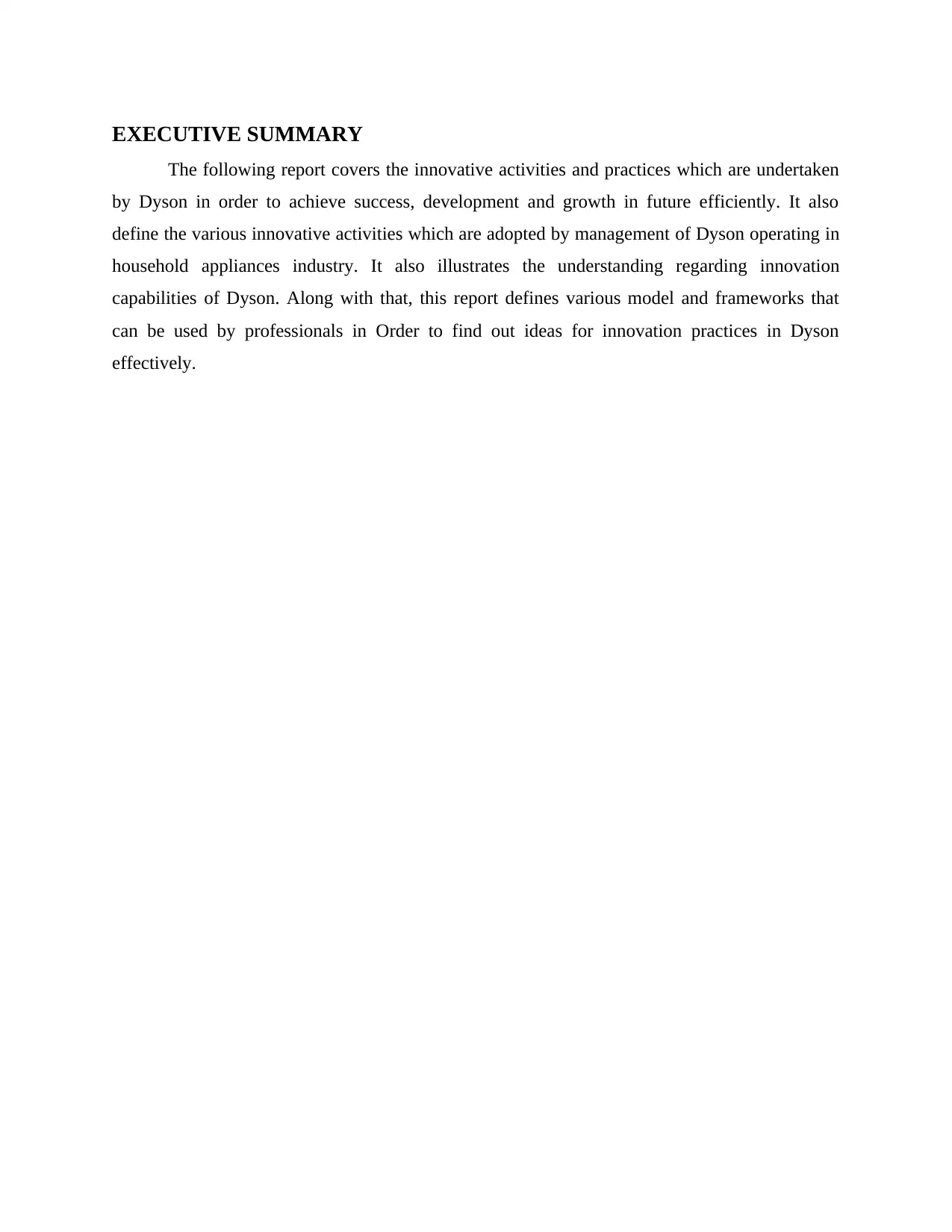
EXECUTIVE SUMMARY
The following report covers the innovative activities and practices which are undertaken
by Dyson in order to achieve success, development and growth in future efficiently. It also
define the various innovative activities which are adopted by management of Dyson operating in
household appliances industry. It also illustrates the understanding regarding innovation
capabilities of Dyson. Along with that, this report defines various model and frameworks that
can be used by professionals in Order to find out ideas for innovation practices in Dyson
effectively.
The following report covers the innovative activities and practices which are undertaken
by Dyson in order to achieve success, development and growth in future efficiently. It also
define the various innovative activities which are adopted by management of Dyson operating in
household appliances industry. It also illustrates the understanding regarding innovation
capabilities of Dyson. Along with that, this report defines various model and frameworks that
can be used by professionals in Order to find out ideas for innovation practices in Dyson
effectively.

Contents
EXECUTIVE SUMMARY ............................................................................................................2
INTRODUCTION...........................................................................................................................1
MAIN BODY ..................................................................................................................................1
The future of the industry 2022 and beyond................................................................................1
The organisations Innovation Requirements 2022 and beyond...................................................2
Building the future innovation capabilities for the organisation ................................................4
CONCLUSION ...............................................................................................................................7
REFERENCES................................................................................................................................9
EXECUTIVE SUMMARY ............................................................................................................2
INTRODUCTION...........................................................................................................................1
MAIN BODY ..................................................................................................................................1
The future of the industry 2022 and beyond................................................................................1
The organisations Innovation Requirements 2022 and beyond...................................................2
Building the future innovation capabilities for the organisation ................................................4
CONCLUSION ...............................................................................................................................7
REFERENCES................................................................................................................................9
⊘ This is a preview!⊘
Do you want full access?
Subscribe today to unlock all pages.

Trusted by 1+ million students worldwide
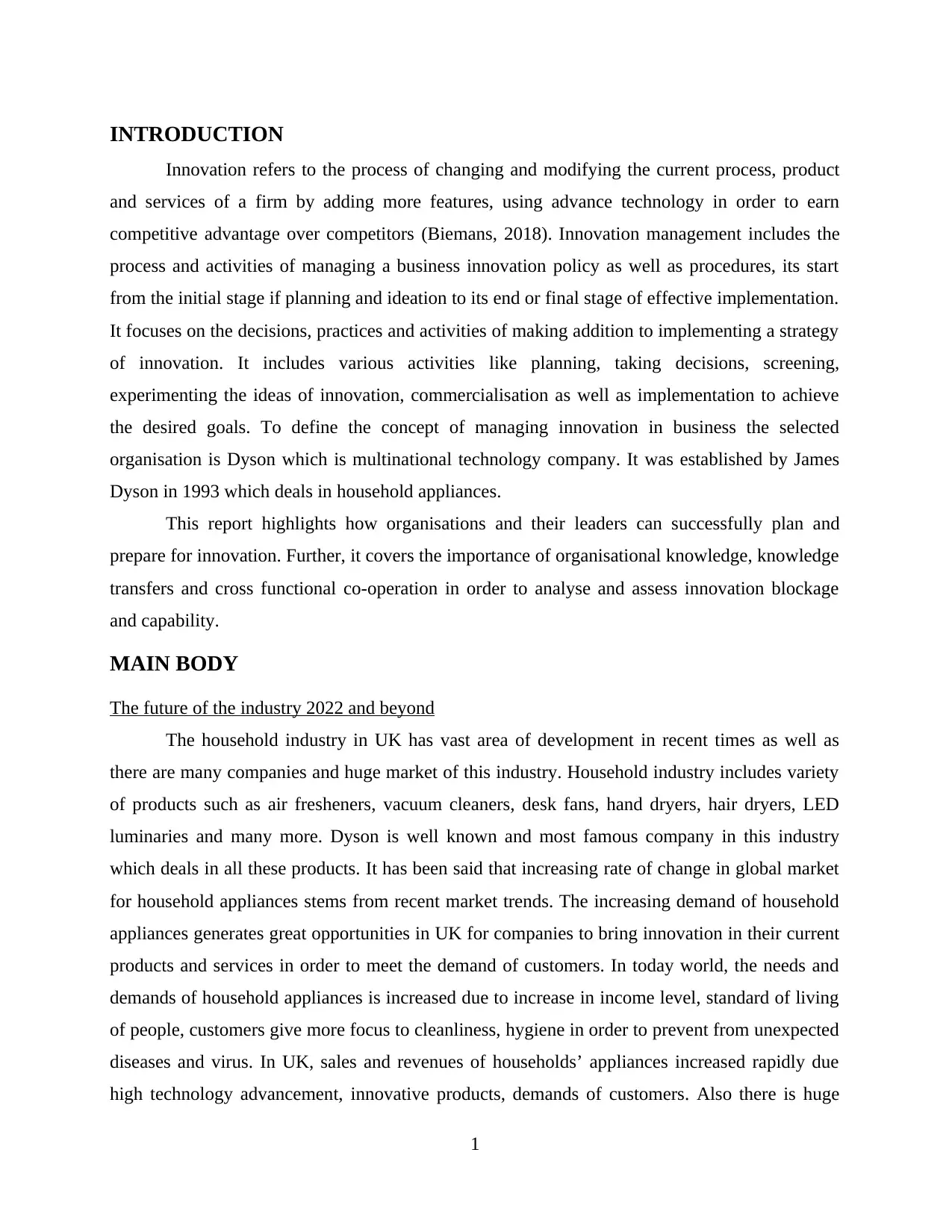
INTRODUCTION
Innovation refers to the process of changing and modifying the current process, product
and services of a firm by adding more features, using advance technology in order to earn
competitive advantage over competitors (Biemans, 2018). Innovation management includes the
process and activities of managing a business innovation policy as well as procedures, its start
from the initial stage if planning and ideation to its end or final stage of effective implementation.
It focuses on the decisions, practices and activities of making addition to implementing a strategy
of innovation. It includes various activities like planning, taking decisions, screening,
experimenting the ideas of innovation, commercialisation as well as implementation to achieve
the desired goals. To define the concept of managing innovation in business the selected
organisation is Dyson which is multinational technology company. It was established by James
Dyson in 1993 which deals in household appliances.
This report highlights how organisations and their leaders can successfully plan and
prepare for innovation. Further, it covers the importance of organisational knowledge, knowledge
transfers and cross functional co-operation in order to analyse and assess innovation blockage
and capability.
MAIN BODY
The future of the industry 2022 and beyond
The household industry in UK has vast area of development in recent times as well as
there are many companies and huge market of this industry. Household industry includes variety
of products such as air fresheners, vacuum cleaners, desk fans, hand dryers, hair dryers, LED
luminaries and many more. Dyson is well known and most famous company in this industry
which deals in all these products. It has been said that increasing rate of change in global market
for household appliances stems from recent market trends. The increasing demand of household
appliances generates great opportunities in UK for companies to bring innovation in their current
products and services in order to meet the demand of customers. In today world, the needs and
demands of household appliances is increased due to increase in income level, standard of living
of people, customers give more focus to cleanliness, hygiene in order to prevent from unexpected
diseases and virus. In UK, sales and revenues of households’ appliances increased rapidly due
high technology advancement, innovative products, demands of customers. Also there is huge
1
Innovation refers to the process of changing and modifying the current process, product
and services of a firm by adding more features, using advance technology in order to earn
competitive advantage over competitors (Biemans, 2018). Innovation management includes the
process and activities of managing a business innovation policy as well as procedures, its start
from the initial stage if planning and ideation to its end or final stage of effective implementation.
It focuses on the decisions, practices and activities of making addition to implementing a strategy
of innovation. It includes various activities like planning, taking decisions, screening,
experimenting the ideas of innovation, commercialisation as well as implementation to achieve
the desired goals. To define the concept of managing innovation in business the selected
organisation is Dyson which is multinational technology company. It was established by James
Dyson in 1993 which deals in household appliances.
This report highlights how organisations and their leaders can successfully plan and
prepare for innovation. Further, it covers the importance of organisational knowledge, knowledge
transfers and cross functional co-operation in order to analyse and assess innovation blockage
and capability.
MAIN BODY
The future of the industry 2022 and beyond
The household industry in UK has vast area of development in recent times as well as
there are many companies and huge market of this industry. Household industry includes variety
of products such as air fresheners, vacuum cleaners, desk fans, hand dryers, hair dryers, LED
luminaries and many more. Dyson is well known and most famous company in this industry
which deals in all these products. It has been said that increasing rate of change in global market
for household appliances stems from recent market trends. The increasing demand of household
appliances generates great opportunities in UK for companies to bring innovation in their current
products and services in order to meet the demand of customers. In today world, the needs and
demands of household appliances is increased due to increase in income level, standard of living
of people, customers give more focus to cleanliness, hygiene in order to prevent from unexpected
diseases and virus. In UK, sales and revenues of households’ appliances increased rapidly due
high technology advancement, innovative products, demands of customers. Also there is huge
1
Paraphrase This Document
Need a fresh take? Get an instant paraphrase of this document with our AI Paraphraser
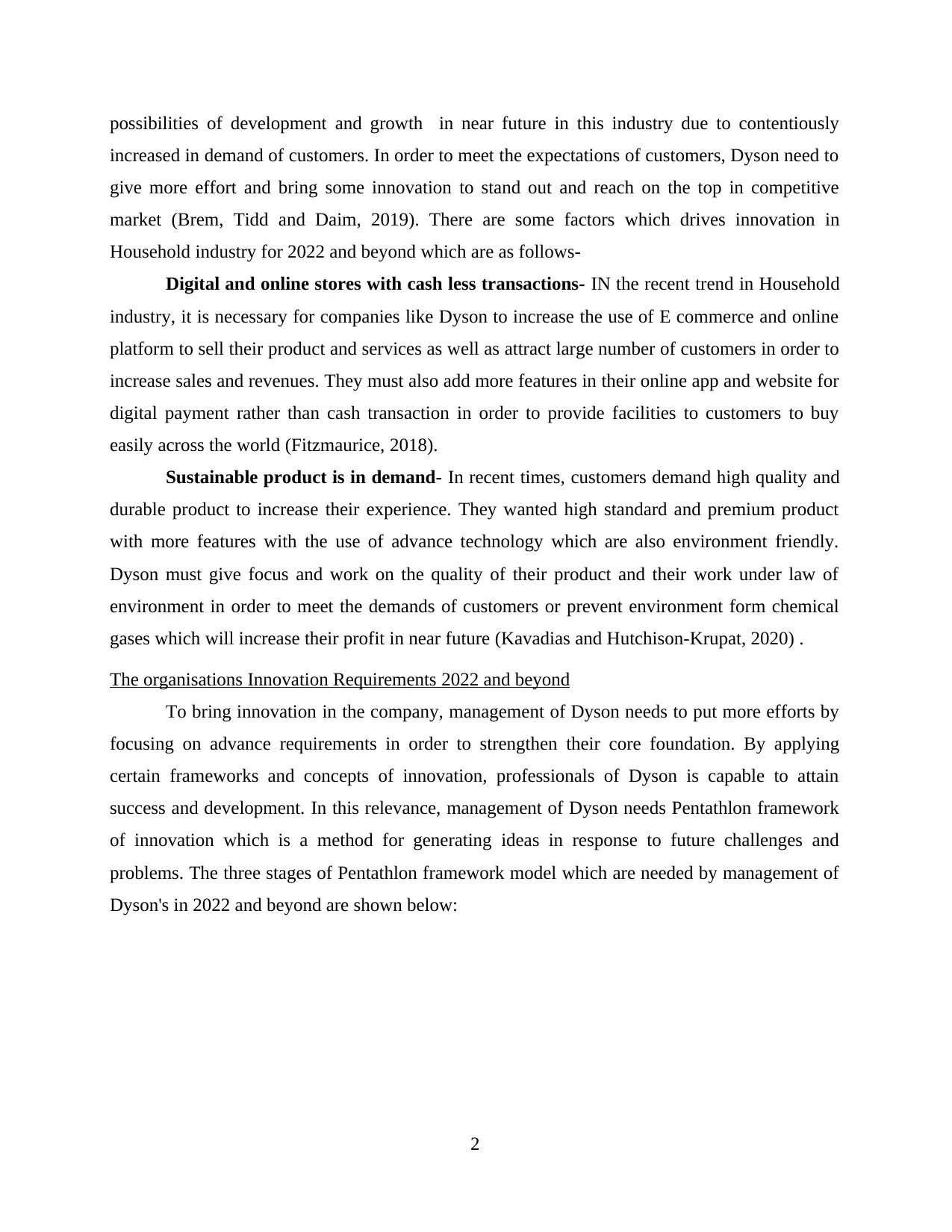
possibilities of development and growth in near future in this industry due to contentiously
increased in demand of customers. In order to meet the expectations of customers, Dyson need to
give more effort and bring some innovation to stand out and reach on the top in competitive
market (Brem, Tidd and Daim, 2019). There are some factors which drives innovation in
Household industry for 2022 and beyond which are as follows-
Digital and online stores with cash less transactions- IN the recent trend in Household
industry, it is necessary for companies like Dyson to increase the use of E commerce and online
platform to sell their product and services as well as attract large number of customers in order to
increase sales and revenues. They must also add more features in their online app and website for
digital payment rather than cash transaction in order to provide facilities to customers to buy
easily across the world (Fitzmaurice, 2018).
Sustainable product is in demand- In recent times, customers demand high quality and
durable product to increase their experience. They wanted high standard and premium product
with more features with the use of advance technology which are also environment friendly.
Dyson must give focus and work on the quality of their product and their work under law of
environment in order to meet the demands of customers or prevent environment form chemical
gases which will increase their profit in near future (Kavadias and Hutchison-Krupat, 2020) .
The organisations Innovation Requirements 2022 and beyond
To bring innovation in the company, management of Dyson needs to put more efforts by
focusing on advance requirements in order to strengthen their core foundation. By applying
certain frameworks and concepts of innovation, professionals of Dyson is capable to attain
success and development. In this relevance, management of Dyson needs Pentathlon framework
of innovation which is a method for generating ideas in response to future challenges and
problems. The three stages of Pentathlon framework model which are needed by management of
Dyson's in 2022 and beyond are shown below:
2
increased in demand of customers. In order to meet the expectations of customers, Dyson need to
give more effort and bring some innovation to stand out and reach on the top in competitive
market (Brem, Tidd and Daim, 2019). There are some factors which drives innovation in
Household industry for 2022 and beyond which are as follows-
Digital and online stores with cash less transactions- IN the recent trend in Household
industry, it is necessary for companies like Dyson to increase the use of E commerce and online
platform to sell their product and services as well as attract large number of customers in order to
increase sales and revenues. They must also add more features in their online app and website for
digital payment rather than cash transaction in order to provide facilities to customers to buy
easily across the world (Fitzmaurice, 2018).
Sustainable product is in demand- In recent times, customers demand high quality and
durable product to increase their experience. They wanted high standard and premium product
with more features with the use of advance technology which are also environment friendly.
Dyson must give focus and work on the quality of their product and their work under law of
environment in order to meet the demands of customers or prevent environment form chemical
gases which will increase their profit in near future (Kavadias and Hutchison-Krupat, 2020) .
The organisations Innovation Requirements 2022 and beyond
To bring innovation in the company, management of Dyson needs to put more efforts by
focusing on advance requirements in order to strengthen their core foundation. By applying
certain frameworks and concepts of innovation, professionals of Dyson is capable to attain
success and development. In this relevance, management of Dyson needs Pentathlon framework
of innovation which is a method for generating ideas in response to future challenges and
problems. The three stages of Pentathlon framework model which are needed by management of
Dyson's in 2022 and beyond are shown below:
2
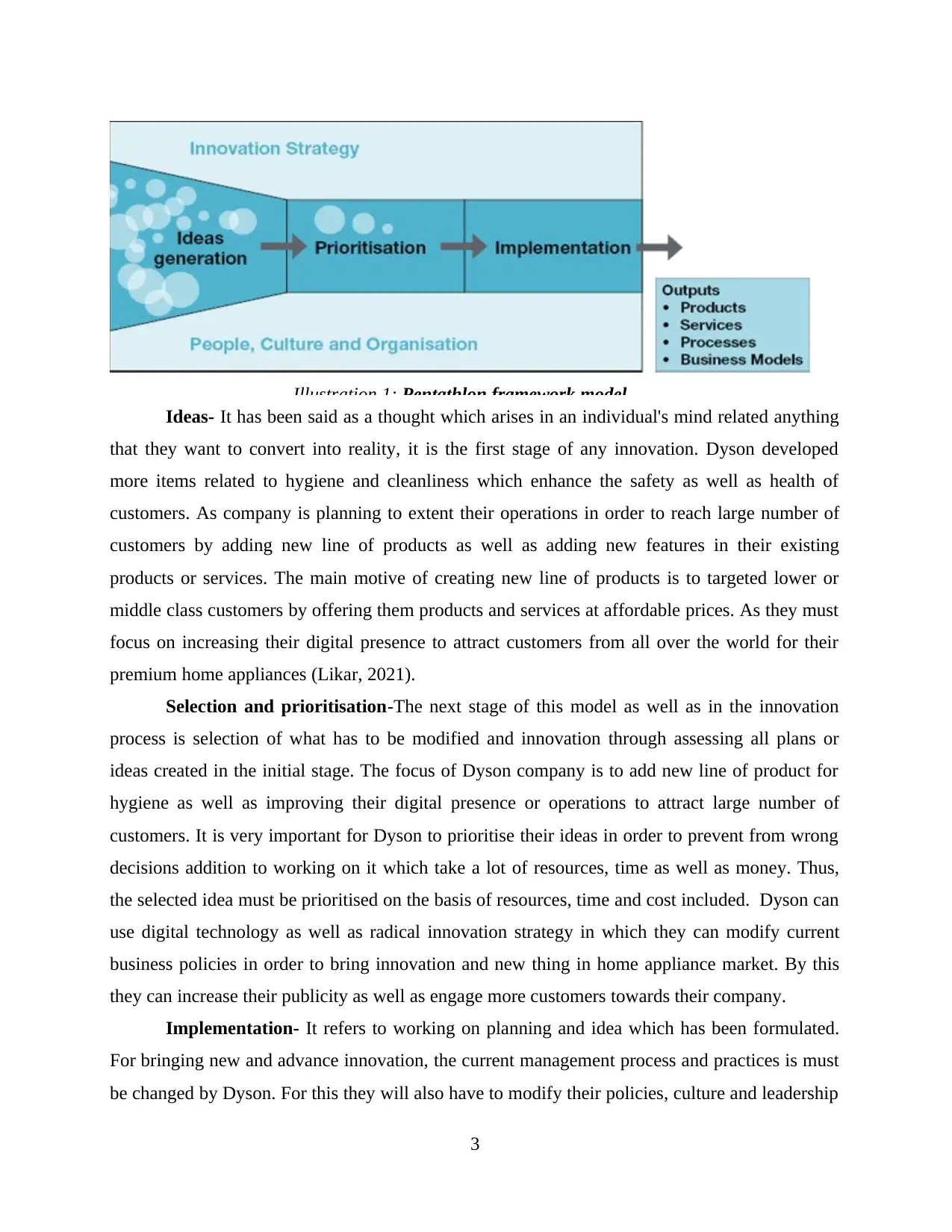
Illustration 1: Pentathlon framework model
Ideas- It has been said as a thought which arises in an individual's mind related anything
that they want to convert into reality, it is the first stage of any innovation. Dyson developed
more items related to hygiene and cleanliness which enhance the safety as well as health of
customers. As company is planning to extent their operations in order to reach large number of
customers by adding new line of products as well as adding new features in their existing
products or services. The main motive of creating new line of products is to targeted lower or
middle class customers by offering them products and services at affordable prices. As they must
focus on increasing their digital presence to attract customers from all over the world for their
premium home appliances (Likar, 2021).
Selection and prioritisation-The next stage of this model as well as in the innovation
process is selection of what has to be modified and innovation through assessing all plans or
ideas created in the initial stage. The focus of Dyson company is to add new line of product for
hygiene as well as improving their digital presence or operations to attract large number of
customers. It is very important for Dyson to prioritise their ideas in order to prevent from wrong
decisions addition to working on it which take a lot of resources, time as well as money. Thus,
the selected idea must be prioritised on the basis of resources, time and cost included. Dyson can
use digital technology as well as radical innovation strategy in which they can modify current
business policies in order to bring innovation and new thing in home appliance market. By this
they can increase their publicity as well as engage more customers towards their company.
Implementation- It refers to working on planning and idea which has been formulated.
For bringing new and advance innovation, the current management process and practices is must
be changed by Dyson. For this they will also have to modify their policies, culture and leadership
3
Ideas- It has been said as a thought which arises in an individual's mind related anything
that they want to convert into reality, it is the first stage of any innovation. Dyson developed
more items related to hygiene and cleanliness which enhance the safety as well as health of
customers. As company is planning to extent their operations in order to reach large number of
customers by adding new line of products as well as adding new features in their existing
products or services. The main motive of creating new line of products is to targeted lower or
middle class customers by offering them products and services at affordable prices. As they must
focus on increasing their digital presence to attract customers from all over the world for their
premium home appliances (Likar, 2021).
Selection and prioritisation-The next stage of this model as well as in the innovation
process is selection of what has to be modified and innovation through assessing all plans or
ideas created in the initial stage. The focus of Dyson company is to add new line of product for
hygiene as well as improving their digital presence or operations to attract large number of
customers. It is very important for Dyson to prioritise their ideas in order to prevent from wrong
decisions addition to working on it which take a lot of resources, time as well as money. Thus,
the selected idea must be prioritised on the basis of resources, time and cost included. Dyson can
use digital technology as well as radical innovation strategy in which they can modify current
business policies in order to bring innovation and new thing in home appliance market. By this
they can increase their publicity as well as engage more customers towards their company.
Implementation- It refers to working on planning and idea which has been formulated.
For bringing new and advance innovation, the current management process and practices is must
be changed by Dyson. For this they will also have to modify their policies, culture and leadership
3
⊘ This is a preview!⊘
Do you want full access?
Subscribe today to unlock all pages.

Trusted by 1+ million students worldwide
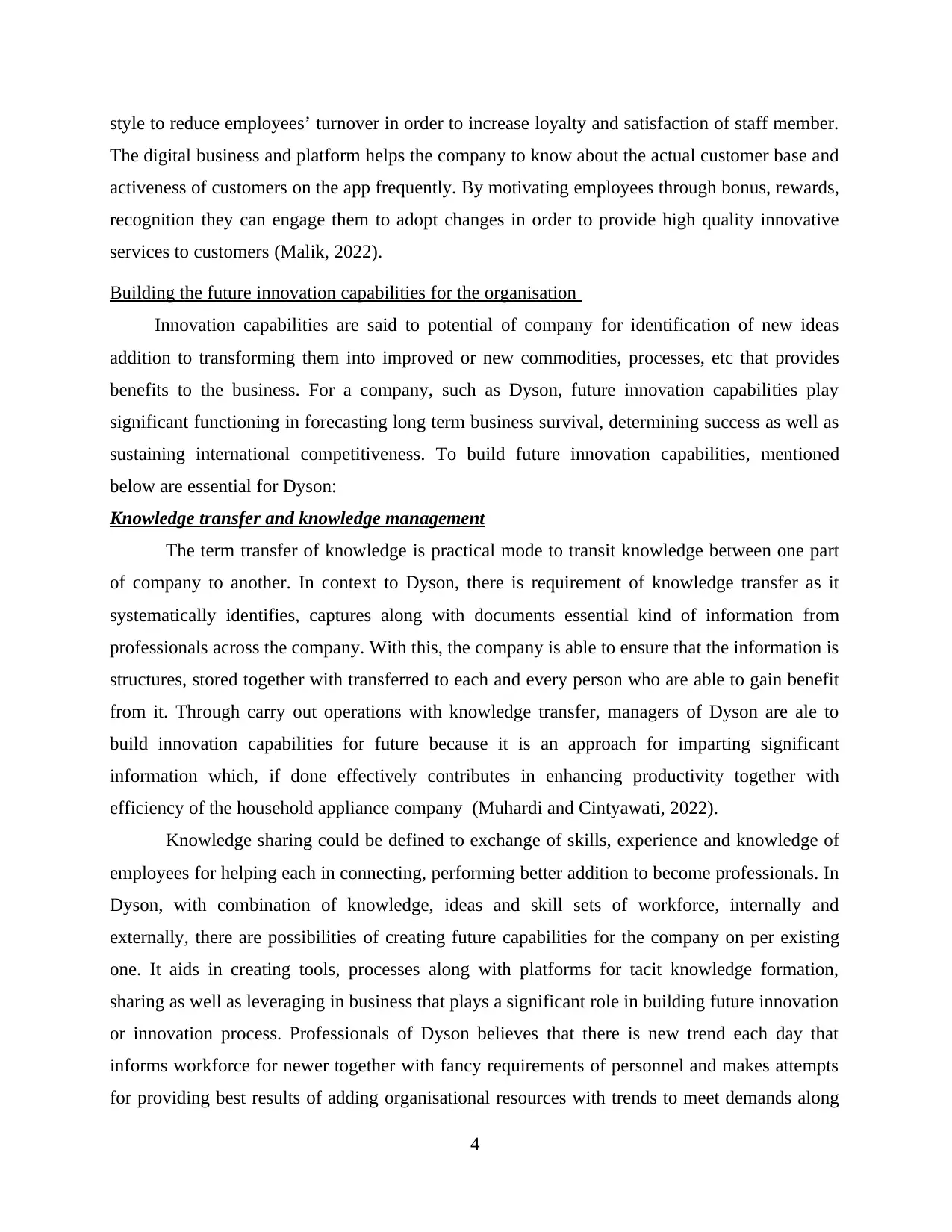
style to reduce employees’ turnover in order to increase loyalty and satisfaction of staff member.
The digital business and platform helps the company to know about the actual customer base and
activeness of customers on the app frequently. By motivating employees through bonus, rewards,
recognition they can engage them to adopt changes in order to provide high quality innovative
services to customers (Malik, 2022).
Building the future innovation capabilities for the organisation
Innovation capabilities are said to potential of company for identification of new ideas
addition to transforming them into improved or new commodities, processes, etc that provides
benefits to the business. For a company, such as Dyson, future innovation capabilities play
significant functioning in forecasting long term business survival, determining success as well as
sustaining international competitiveness. To build future innovation capabilities, mentioned
below are essential for Dyson:
Knowledge transfer and knowledge management
The term transfer of knowledge is practical mode to transit knowledge between one part
of company to another. In context to Dyson, there is requirement of knowledge transfer as it
systematically identifies, captures along with documents essential kind of information from
professionals across the company. With this, the company is able to ensure that the information is
structures, stored together with transferred to each and every person who are able to gain benefit
from it. Through carry out operations with knowledge transfer, managers of Dyson are ale to
build innovation capabilities for future because it is an approach for imparting significant
information which, if done effectively contributes in enhancing productivity together with
efficiency of the household appliance company (Muhardi and Cintyawati, 2022).
Knowledge sharing could be defined to exchange of skills, experience and knowledge of
employees for helping each in connecting, performing better addition to become professionals. In
Dyson, with combination of knowledge, ideas and skill sets of workforce, internally and
externally, there are possibilities of creating future capabilities for the company on per existing
one. It aids in creating tools, processes along with platforms for tacit knowledge formation,
sharing as well as leveraging in business that plays a significant role in building future innovation
or innovation process. Professionals of Dyson believes that there is new trend each day that
informs workforce for newer together with fancy requirements of personnel and makes attempts
for providing best results of adding organisational resources with trends to meet demands along
4
The digital business and platform helps the company to know about the actual customer base and
activeness of customers on the app frequently. By motivating employees through bonus, rewards,
recognition they can engage them to adopt changes in order to provide high quality innovative
services to customers (Malik, 2022).
Building the future innovation capabilities for the organisation
Innovation capabilities are said to potential of company for identification of new ideas
addition to transforming them into improved or new commodities, processes, etc that provides
benefits to the business. For a company, such as Dyson, future innovation capabilities play
significant functioning in forecasting long term business survival, determining success as well as
sustaining international competitiveness. To build future innovation capabilities, mentioned
below are essential for Dyson:
Knowledge transfer and knowledge management
The term transfer of knowledge is practical mode to transit knowledge between one part
of company to another. In context to Dyson, there is requirement of knowledge transfer as it
systematically identifies, captures along with documents essential kind of information from
professionals across the company. With this, the company is able to ensure that the information is
structures, stored together with transferred to each and every person who are able to gain benefit
from it. Through carry out operations with knowledge transfer, managers of Dyson are ale to
build innovation capabilities for future because it is an approach for imparting significant
information which, if done effectively contributes in enhancing productivity together with
efficiency of the household appliance company (Muhardi and Cintyawati, 2022).
Knowledge sharing could be defined to exchange of skills, experience and knowledge of
employees for helping each in connecting, performing better addition to become professionals. In
Dyson, with combination of knowledge, ideas and skill sets of workforce, internally and
externally, there are possibilities of creating future capabilities for the company on per existing
one. It aids in creating tools, processes along with platforms for tacit knowledge formation,
sharing as well as leveraging in business that plays a significant role in building future innovation
or innovation process. Professionals of Dyson believes that there is new trend each day that
informs workforce for newer together with fancy requirements of personnel and makes attempts
for providing best results of adding organisational resources with trends to meet demands along
4
Paraphrase This Document
Need a fresh take? Get an instant paraphrase of this document with our AI Paraphraser

with creating household appliance in market. Knowledge sharing helps the establishment to
develop more innovative techniques addition to devices at the time of merger of real needs with
pre-existing knowledge which the establishment have to perform well through launching
innovations which target audience demands from the company (Perrini and Russo, 2019).
Organisational culture, leadership and climate
Organisational culture is collection of traits which makes the business concern what it is.
In accordance to Handy’s cultural model, there are certain cultures that a company follows. One
is power culture that says that there are some companies in which power is in hands of few
people with authority to devise decisions. Next is task culture that states that companies in which
teams are formed for the purpose of attaining targets and problem solving of critical situations
follows it. Another is person culture in which personnel work with feeling that they are
significant than the company. At last, role culture is kind of culture in which delegation to each
personnel are carried out as per their specialisation, interest and qualification for extracting best
from them. To build future innovation capabilities, Dyson follows role culture that allows
expertise for reigning over power and helping staff members in exercising addition to feeling
some sort of control. Through exchanging how people work in order to deliver results more
creatively addition to innovatively, organisational culture supports future innovation (Pol, 2021).
Leadership comprises of potential of a person, group and team to guide or influence
others. In a company, it is responsibility of a leader to build an environment of openness and
promote it so to drive innovation development for future period. In Dyson, leaders assist
workforce through sharing own knowledge and experiences at work. Application of
transformational leadership style encourages, motivates and inspires manpower for innovations
and working on the change that further lead to growth as well as shaping future success of the
firm. With individualised consideration, transformational leaders of the household appliance
company build separable relationships with superiors and subordinates together with esteem their
capabilities and ambitions that contribute in developing innovation capabilities (Ratten and
Usmanij, 2020).
Organisational climate is long lasting perception of a workforce about working
environment as well as culture of company wherein they work. In a company, innovation
oriented climate emphasises towards intellectual practices addition to processes of an individual
which create foster creation or building competence for new ideas, insights together with
5
develop more innovative techniques addition to devices at the time of merger of real needs with
pre-existing knowledge which the establishment have to perform well through launching
innovations which target audience demands from the company (Perrini and Russo, 2019).
Organisational culture, leadership and climate
Organisational culture is collection of traits which makes the business concern what it is.
In accordance to Handy’s cultural model, there are certain cultures that a company follows. One
is power culture that says that there are some companies in which power is in hands of few
people with authority to devise decisions. Next is task culture that states that companies in which
teams are formed for the purpose of attaining targets and problem solving of critical situations
follows it. Another is person culture in which personnel work with feeling that they are
significant than the company. At last, role culture is kind of culture in which delegation to each
personnel are carried out as per their specialisation, interest and qualification for extracting best
from them. To build future innovation capabilities, Dyson follows role culture that allows
expertise for reigning over power and helping staff members in exercising addition to feeling
some sort of control. Through exchanging how people work in order to deliver results more
creatively addition to innovatively, organisational culture supports future innovation (Pol, 2021).
Leadership comprises of potential of a person, group and team to guide or influence
others. In a company, it is responsibility of a leader to build an environment of openness and
promote it so to drive innovation development for future period. In Dyson, leaders assist
workforce through sharing own knowledge and experiences at work. Application of
transformational leadership style encourages, motivates and inspires manpower for innovations
and working on the change that further lead to growth as well as shaping future success of the
firm. With individualised consideration, transformational leaders of the household appliance
company build separable relationships with superiors and subordinates together with esteem their
capabilities and ambitions that contribute in developing innovation capabilities (Ratten and
Usmanij, 2020).
Organisational climate is long lasting perception of a workforce about working
environment as well as culture of company wherein they work. In a company, innovation
oriented climate emphasises towards intellectual practices addition to processes of an individual
which create foster creation or building competence for new ideas, insights together with
5
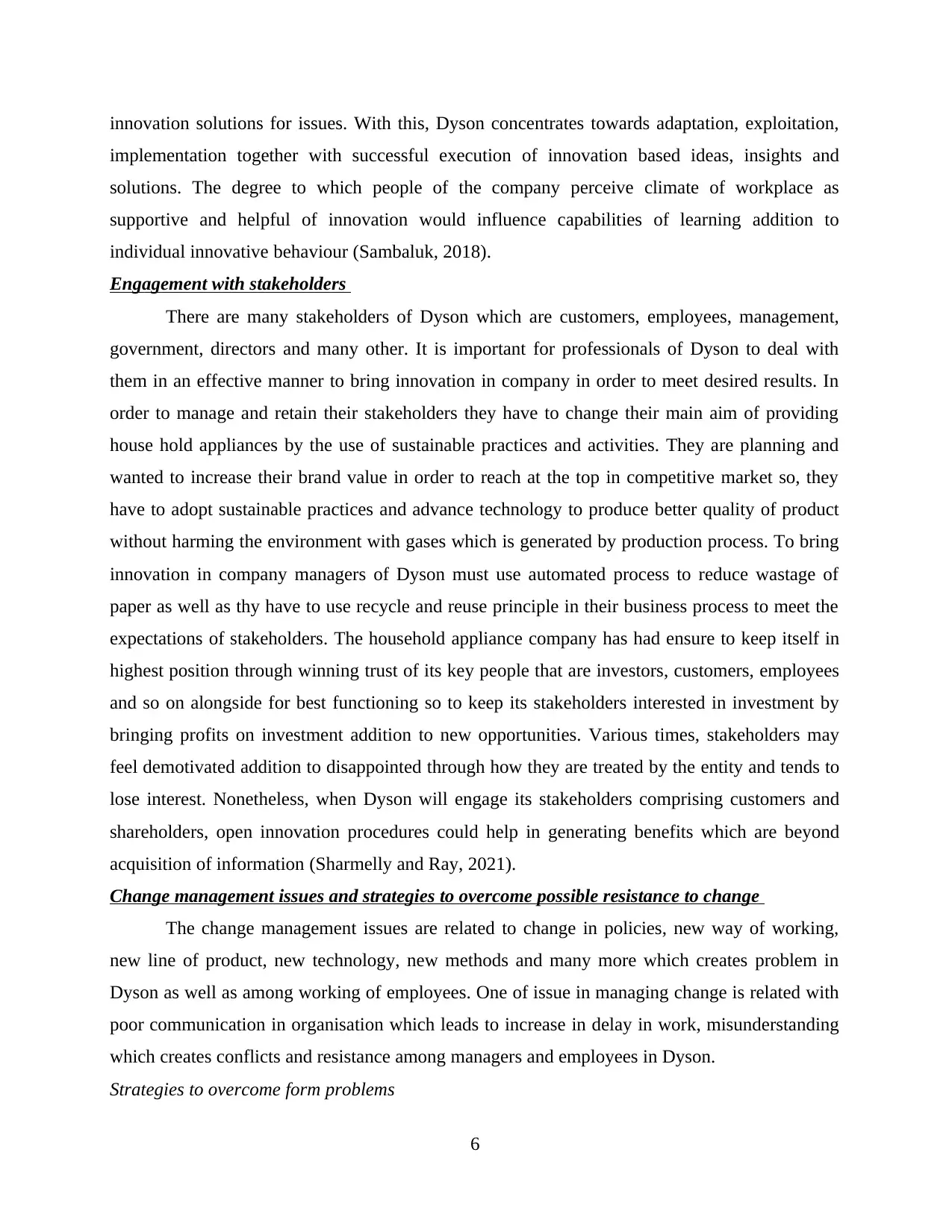
innovation solutions for issues. With this, Dyson concentrates towards adaptation, exploitation,
implementation together with successful execution of innovation based ideas, insights and
solutions. The degree to which people of the company perceive climate of workplace as
supportive and helpful of innovation would influence capabilities of learning addition to
individual innovative behaviour (Sambaluk, 2018).
Engagement with stakeholders
There are many stakeholders of Dyson which are customers, employees, management,
government, directors and many other. It is important for professionals of Dyson to deal with
them in an effective manner to bring innovation in company in order to meet desired results. In
order to manage and retain their stakeholders they have to change their main aim of providing
house hold appliances by the use of sustainable practices and activities. They are planning and
wanted to increase their brand value in order to reach at the top in competitive market so, they
have to adopt sustainable practices and advance technology to produce better quality of product
without harming the environment with gases which is generated by production process. To bring
innovation in company managers of Dyson must use automated process to reduce wastage of
paper as well as thy have to use recycle and reuse principle in their business process to meet the
expectations of stakeholders. The household appliance company has had ensure to keep itself in
highest position through winning trust of its key people that are investors, customers, employees
and so on alongside for best functioning so to keep its stakeholders interested in investment by
bringing profits on investment addition to new opportunities. Various times, stakeholders may
feel demotivated addition to disappointed through how they are treated by the entity and tends to
lose interest. Nonetheless, when Dyson will engage its stakeholders comprising customers and
shareholders, open innovation procedures could help in generating benefits which are beyond
acquisition of information (Sharmelly and Ray, 2021).
Change management issues and strategies to overcome possible resistance to change
The change management issues are related to change in policies, new way of working,
new line of product, new technology, new methods and many more which creates problem in
Dyson as well as among working of employees. One of issue in managing change is related with
poor communication in organisation which leads to increase in delay in work, misunderstanding
which creates conflicts and resistance among managers and employees in Dyson.
Strategies to overcome form problems
6
implementation together with successful execution of innovation based ideas, insights and
solutions. The degree to which people of the company perceive climate of workplace as
supportive and helpful of innovation would influence capabilities of learning addition to
individual innovative behaviour (Sambaluk, 2018).
Engagement with stakeholders
There are many stakeholders of Dyson which are customers, employees, management,
government, directors and many other. It is important for professionals of Dyson to deal with
them in an effective manner to bring innovation in company in order to meet desired results. In
order to manage and retain their stakeholders they have to change their main aim of providing
house hold appliances by the use of sustainable practices and activities. They are planning and
wanted to increase their brand value in order to reach at the top in competitive market so, they
have to adopt sustainable practices and advance technology to produce better quality of product
without harming the environment with gases which is generated by production process. To bring
innovation in company managers of Dyson must use automated process to reduce wastage of
paper as well as thy have to use recycle and reuse principle in their business process to meet the
expectations of stakeholders. The household appliance company has had ensure to keep itself in
highest position through winning trust of its key people that are investors, customers, employees
and so on alongside for best functioning so to keep its stakeholders interested in investment by
bringing profits on investment addition to new opportunities. Various times, stakeholders may
feel demotivated addition to disappointed through how they are treated by the entity and tends to
lose interest. Nonetheless, when Dyson will engage its stakeholders comprising customers and
shareholders, open innovation procedures could help in generating benefits which are beyond
acquisition of information (Sharmelly and Ray, 2021).
Change management issues and strategies to overcome possible resistance to change
The change management issues are related to change in policies, new way of working,
new line of product, new technology, new methods and many more which creates problem in
Dyson as well as among working of employees. One of issue in managing change is related with
poor communication in organisation which leads to increase in delay in work, misunderstanding
which creates conflicts and resistance among managers and employees in Dyson.
Strategies to overcome form problems
6
⊘ This is a preview!⊘
Do you want full access?
Subscribe today to unlock all pages.

Trusted by 1+ million students worldwide

In order to overcome from this issues management as well as resistance to change,
managers can use Lewin's change model which are as follows-
Lewin's change model has three stages which is Unfreeze, change and refreeze which helps them
to implement changes effectively to achieve success in future (Stubbs, 2019).
Unfreeze- In this stage, management of Dyson improve the capabilities and willing of
employees by informing them about changes in advance as well as giving them training to adopt
changes like new way of working and advance technology in their performance. By effective
communication and allow people to interact better with other they can motivate employees to
give full support in the change process (Tan, 2020).
Change- In this stage, manager bring and implement innovative changes in their
leadership style, working and other aspects. After uncertainty developed in unfreeze phase, at
change stage, people of company begin resolving uncertainty as well as look towards new ways
for carry out things. In this, people of Dyson would start to believe addition to act in a manner
which supports new direction. It is recommended to people of the company to accept change
along with contribute in making the innovation and company successful (Thornblad, 2018) .
Refreeze- At a time, when changes take place as well as people embraced new working
ways, organisational people are ready for refreezing. In Dyson, outward signs of refreezing can
be consistent descriptions of job, organisational chart and many more. At this stage, it is
recommended to people to assist each other and company for institutionalising as well as
internalising changes. With new sense of stability, people are tends to feel comfortable along
with confident in innovative working ways (Tiwari and Buse, 2019).
CONCLUSION
As per above presented information, it has been concluded that it is important for any
organisation to make changes in their current process, procedures, Culture, management as well
as product or services in become successful in competitive market. It is necessary for
management to bring some innovation in their current activities in order to make their product
different form competitors and gain competitive advantage. It helps them to bring newness in
their internal organisation which increase the morale and engagement of employees. As they can
also improve their productivity and performance which helps the company to increase their profit
margin, customers base and market share. By using digital techniques, they can transform their
working process, policies and production methods by using advance online technology. It
7
managers can use Lewin's change model which are as follows-
Lewin's change model has three stages which is Unfreeze, change and refreeze which helps them
to implement changes effectively to achieve success in future (Stubbs, 2019).
Unfreeze- In this stage, management of Dyson improve the capabilities and willing of
employees by informing them about changes in advance as well as giving them training to adopt
changes like new way of working and advance technology in their performance. By effective
communication and allow people to interact better with other they can motivate employees to
give full support in the change process (Tan, 2020).
Change- In this stage, manager bring and implement innovative changes in their
leadership style, working and other aspects. After uncertainty developed in unfreeze phase, at
change stage, people of company begin resolving uncertainty as well as look towards new ways
for carry out things. In this, people of Dyson would start to believe addition to act in a manner
which supports new direction. It is recommended to people of the company to accept change
along with contribute in making the innovation and company successful (Thornblad, 2018) .
Refreeze- At a time, when changes take place as well as people embraced new working
ways, organisational people are ready for refreezing. In Dyson, outward signs of refreezing can
be consistent descriptions of job, organisational chart and many more. At this stage, it is
recommended to people to assist each other and company for institutionalising as well as
internalising changes. With new sense of stability, people are tends to feel comfortable along
with confident in innovative working ways (Tiwari and Buse, 2019).
CONCLUSION
As per above presented information, it has been concluded that it is important for any
organisation to make changes in their current process, procedures, Culture, management as well
as product or services in become successful in competitive market. It is necessary for
management to bring some innovation in their current activities in order to make their product
different form competitors and gain competitive advantage. It helps them to bring newness in
their internal organisation which increase the morale and engagement of employees. As they can
also improve their productivity and performance which helps the company to increase their profit
margin, customers base and market share. By using digital techniques, they can transform their
working process, policies and production methods by using advance online technology. It
7
Paraphrase This Document
Need a fresh take? Get an instant paraphrase of this document with our AI Paraphraser
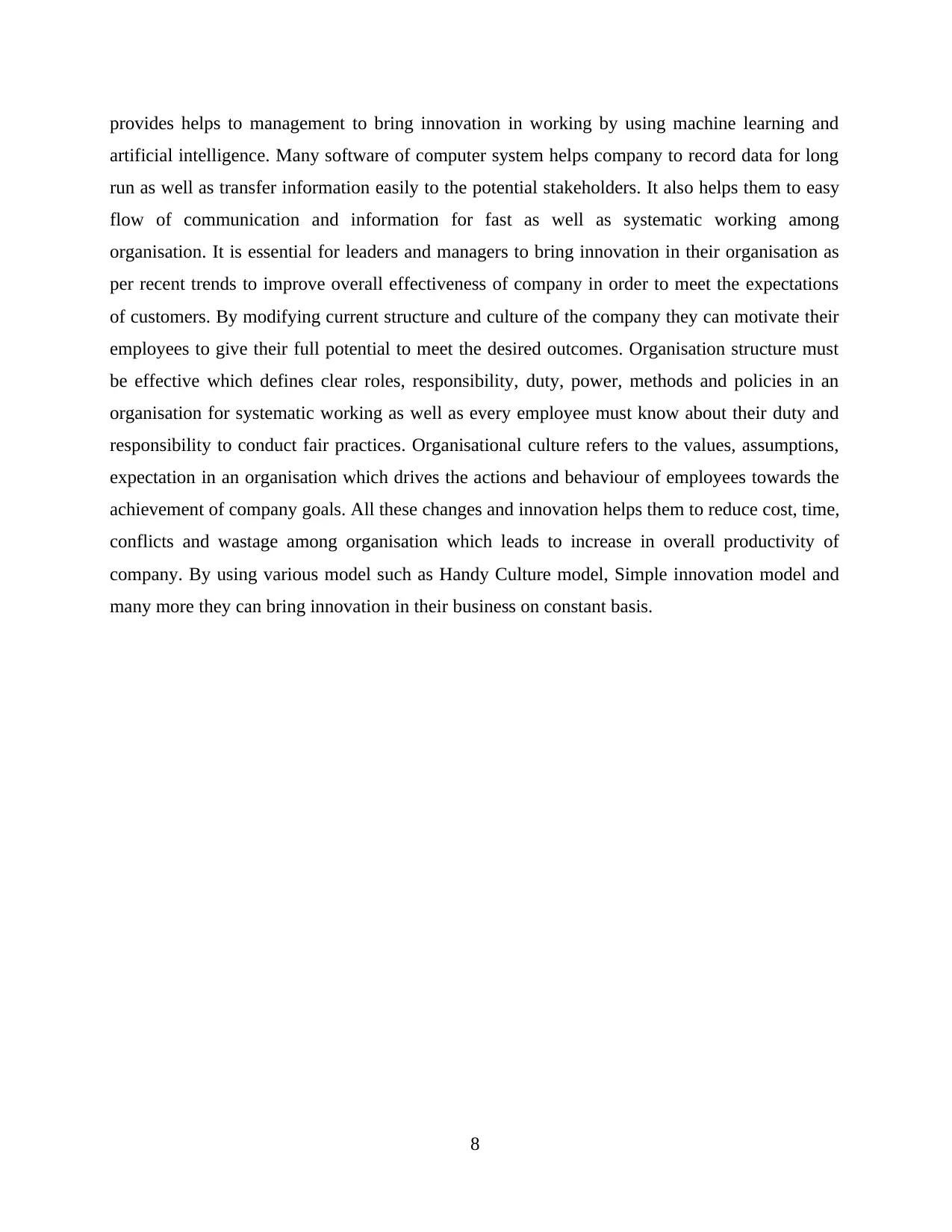
provides helps to management to bring innovation in working by using machine learning and
artificial intelligence. Many software of computer system helps company to record data for long
run as well as transfer information easily to the potential stakeholders. It also helps them to easy
flow of communication and information for fast as well as systematic working among
organisation. It is essential for leaders and managers to bring innovation in their organisation as
per recent trends to improve overall effectiveness of company in order to meet the expectations
of customers. By modifying current structure and culture of the company they can motivate their
employees to give their full potential to meet the desired outcomes. Organisation structure must
be effective which defines clear roles, responsibility, duty, power, methods and policies in an
organisation for systematic working as well as every employee must know about their duty and
responsibility to conduct fair practices. Organisational culture refers to the values, assumptions,
expectation in an organisation which drives the actions and behaviour of employees towards the
achievement of company goals. All these changes and innovation helps them to reduce cost, time,
conflicts and wastage among organisation which leads to increase in overall productivity of
company. By using various model such as Handy Culture model, Simple innovation model and
many more they can bring innovation in their business on constant basis.
8
artificial intelligence. Many software of computer system helps company to record data for long
run as well as transfer information easily to the potential stakeholders. It also helps them to easy
flow of communication and information for fast as well as systematic working among
organisation. It is essential for leaders and managers to bring innovation in their organisation as
per recent trends to improve overall effectiveness of company in order to meet the expectations
of customers. By modifying current structure and culture of the company they can motivate their
employees to give their full potential to meet the desired outcomes. Organisation structure must
be effective which defines clear roles, responsibility, duty, power, methods and policies in an
organisation for systematic working as well as every employee must know about their duty and
responsibility to conduct fair practices. Organisational culture refers to the values, assumptions,
expectation in an organisation which drives the actions and behaviour of employees towards the
achievement of company goals. All these changes and innovation helps them to reduce cost, time,
conflicts and wastage among organisation which leads to increase in overall productivity of
company. By using various model such as Handy Culture model, Simple innovation model and
many more they can bring innovation in their business on constant basis.
8
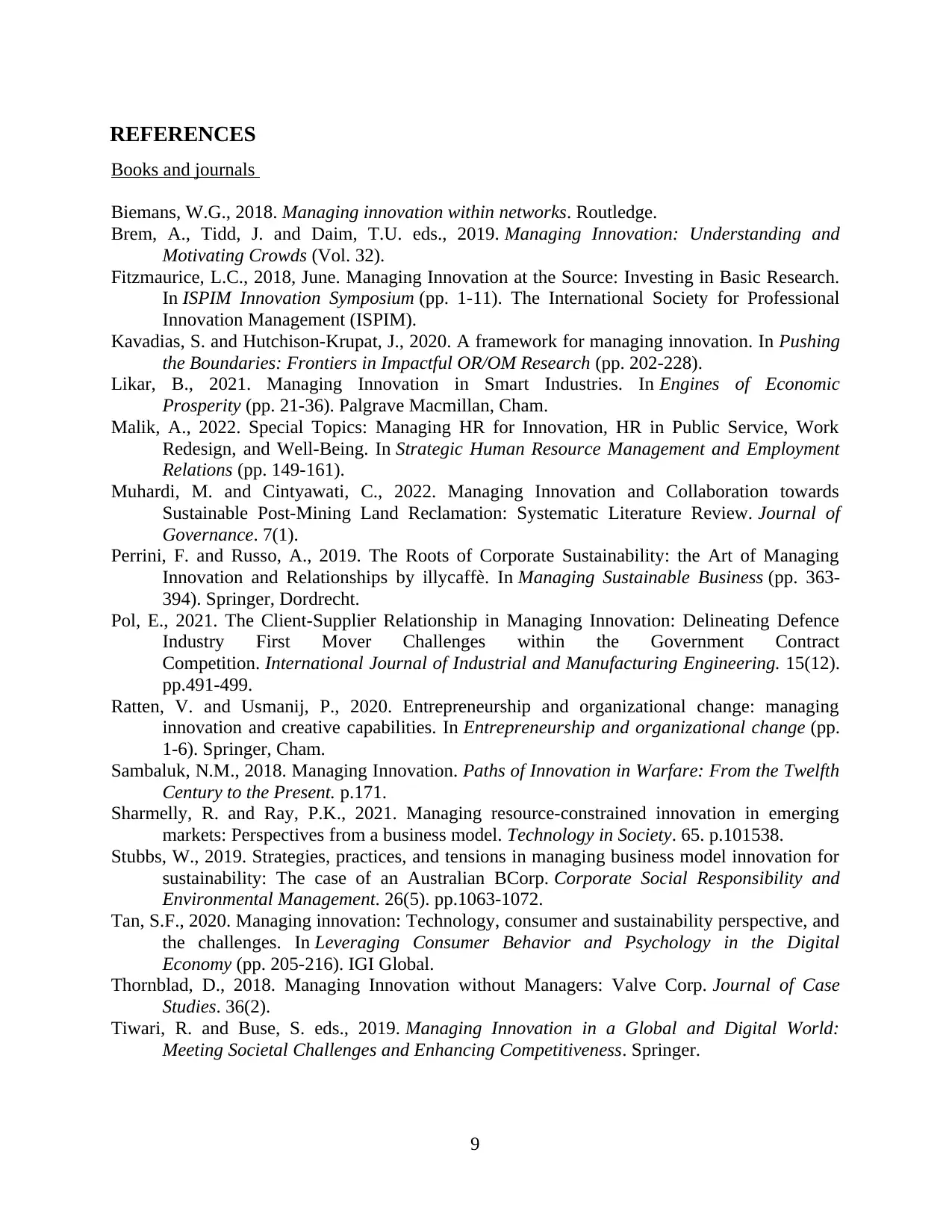
REFERENCES
Books and journals
Biemans, W.G., 2018. Managing innovation within networks. Routledge.
Brem, A., Tidd, J. and Daim, T.U. eds., 2019. Managing Innovation: Understanding and
Motivating Crowds (Vol. 32).
Fitzmaurice, L.C., 2018, June. Managing Innovation at the Source: Investing in Basic Research.
In ISPIM Innovation Symposium (pp. 1-11). The International Society for Professional
Innovation Management (ISPIM).
Kavadias, S. and Hutchison-Krupat, J., 2020. A framework for managing innovation. In Pushing
the Boundaries: Frontiers in Impactful OR/OM Research (pp. 202-228).
Likar, B., 2021. Managing Innovation in Smart Industries. In Engines of Economic
Prosperity (pp. 21-36). Palgrave Macmillan, Cham.
Malik, A., 2022. Special Topics: Managing HR for Innovation, HR in Public Service, Work
Redesign, and Well-Being. In Strategic Human Resource Management and Employment
Relations (pp. 149-161).
Muhardi, M. and Cintyawati, C., 2022. Managing Innovation and Collaboration towards
Sustainable Post-Mining Land Reclamation: Systematic Literature Review. Journal of
Governance. 7(1).
Perrini, F. and Russo, A., 2019. The Roots of Corporate Sustainability: the Art of Managing
Innovation and Relationships by illycaffè. In Managing Sustainable Business (pp. 363-
394). Springer, Dordrecht.
Pol, E., 2021. The Client-Supplier Relationship in Managing Innovation: Delineating Defence
Industry First Mover Challenges within the Government Contract
Competition. International Journal of Industrial and Manufacturing Engineering. 15(12).
pp.491-499.
Ratten, V. and Usmanij, P., 2020. Entrepreneurship and organizational change: managing
innovation and creative capabilities. In Entrepreneurship and organizational change (pp.
1-6). Springer, Cham.
Sambaluk, N.M., 2018. Managing Innovation. Paths of Innovation in Warfare: From the Twelfth
Century to the Present. p.171.
Sharmelly, R. and Ray, P.K., 2021. Managing resource-constrained innovation in emerging
markets: Perspectives from a business model. Technology in Society. 65. p.101538.
Stubbs, W., 2019. Strategies, practices, and tensions in managing business model innovation for
sustainability: The case of an Australian BCorp. Corporate Social Responsibility and
Environmental Management. 26(5). pp.1063-1072.
Tan, S.F., 2020. Managing innovation: Technology, consumer and sustainability perspective, and
the challenges. In Leveraging Consumer Behavior and Psychology in the Digital
Economy (pp. 205-216). IGI Global.
Thornblad, D., 2018. Managing Innovation without Managers: Valve Corp. Journal of Case
Studies. 36(2).
Tiwari, R. and Buse, S. eds., 2019. Managing Innovation in a Global and Digital World:
Meeting Societal Challenges and Enhancing Competitiveness. Springer.
9
Books and journals
Biemans, W.G., 2018. Managing innovation within networks. Routledge.
Brem, A., Tidd, J. and Daim, T.U. eds., 2019. Managing Innovation: Understanding and
Motivating Crowds (Vol. 32).
Fitzmaurice, L.C., 2018, June. Managing Innovation at the Source: Investing in Basic Research.
In ISPIM Innovation Symposium (pp. 1-11). The International Society for Professional
Innovation Management (ISPIM).
Kavadias, S. and Hutchison-Krupat, J., 2020. A framework for managing innovation. In Pushing
the Boundaries: Frontiers in Impactful OR/OM Research (pp. 202-228).
Likar, B., 2021. Managing Innovation in Smart Industries. In Engines of Economic
Prosperity (pp. 21-36). Palgrave Macmillan, Cham.
Malik, A., 2022. Special Topics: Managing HR for Innovation, HR in Public Service, Work
Redesign, and Well-Being. In Strategic Human Resource Management and Employment
Relations (pp. 149-161).
Muhardi, M. and Cintyawati, C., 2022. Managing Innovation and Collaboration towards
Sustainable Post-Mining Land Reclamation: Systematic Literature Review. Journal of
Governance. 7(1).
Perrini, F. and Russo, A., 2019. The Roots of Corporate Sustainability: the Art of Managing
Innovation and Relationships by illycaffè. In Managing Sustainable Business (pp. 363-
394). Springer, Dordrecht.
Pol, E., 2021. The Client-Supplier Relationship in Managing Innovation: Delineating Defence
Industry First Mover Challenges within the Government Contract
Competition. International Journal of Industrial and Manufacturing Engineering. 15(12).
pp.491-499.
Ratten, V. and Usmanij, P., 2020. Entrepreneurship and organizational change: managing
innovation and creative capabilities. In Entrepreneurship and organizational change (pp.
1-6). Springer, Cham.
Sambaluk, N.M., 2018. Managing Innovation. Paths of Innovation in Warfare: From the Twelfth
Century to the Present. p.171.
Sharmelly, R. and Ray, P.K., 2021. Managing resource-constrained innovation in emerging
markets: Perspectives from a business model. Technology in Society. 65. p.101538.
Stubbs, W., 2019. Strategies, practices, and tensions in managing business model innovation for
sustainability: The case of an Australian BCorp. Corporate Social Responsibility and
Environmental Management. 26(5). pp.1063-1072.
Tan, S.F., 2020. Managing innovation: Technology, consumer and sustainability perspective, and
the challenges. In Leveraging Consumer Behavior and Psychology in the Digital
Economy (pp. 205-216). IGI Global.
Thornblad, D., 2018. Managing Innovation without Managers: Valve Corp. Journal of Case
Studies. 36(2).
Tiwari, R. and Buse, S. eds., 2019. Managing Innovation in a Global and Digital World:
Meeting Societal Challenges and Enhancing Competitiveness. Springer.
9
⊘ This is a preview!⊘
Do you want full access?
Subscribe today to unlock all pages.

Trusted by 1+ million students worldwide
1 out of 12
Related Documents
Your All-in-One AI-Powered Toolkit for Academic Success.
+13062052269
info@desklib.com
Available 24*7 on WhatsApp / Email
![[object Object]](/_next/static/media/star-bottom.7253800d.svg)
Unlock your academic potential
Copyright © 2020–2025 A2Z Services. All Rights Reserved. Developed and managed by ZUCOL.




